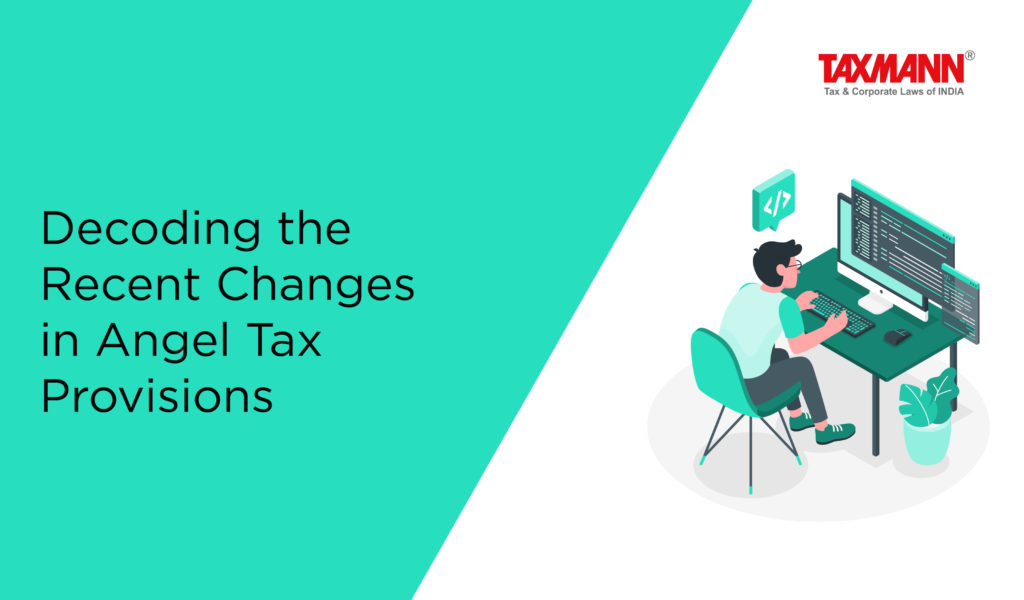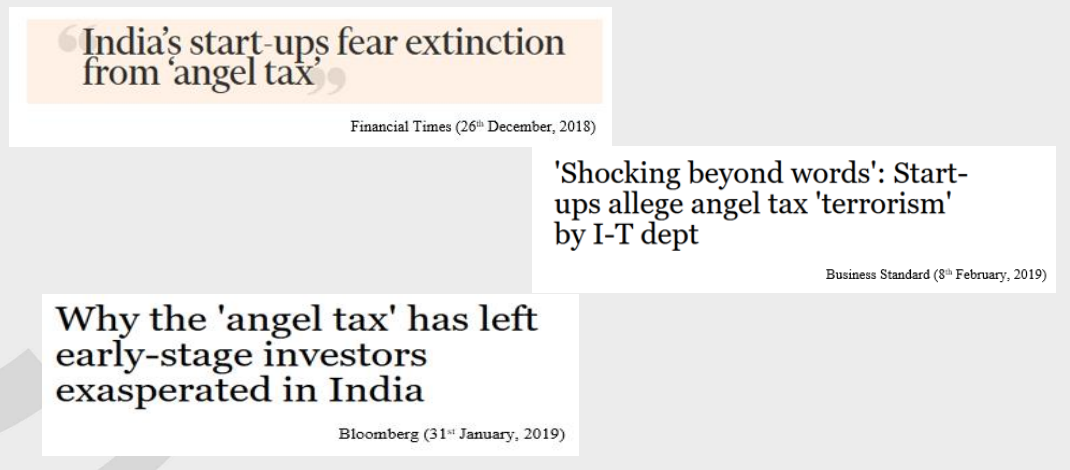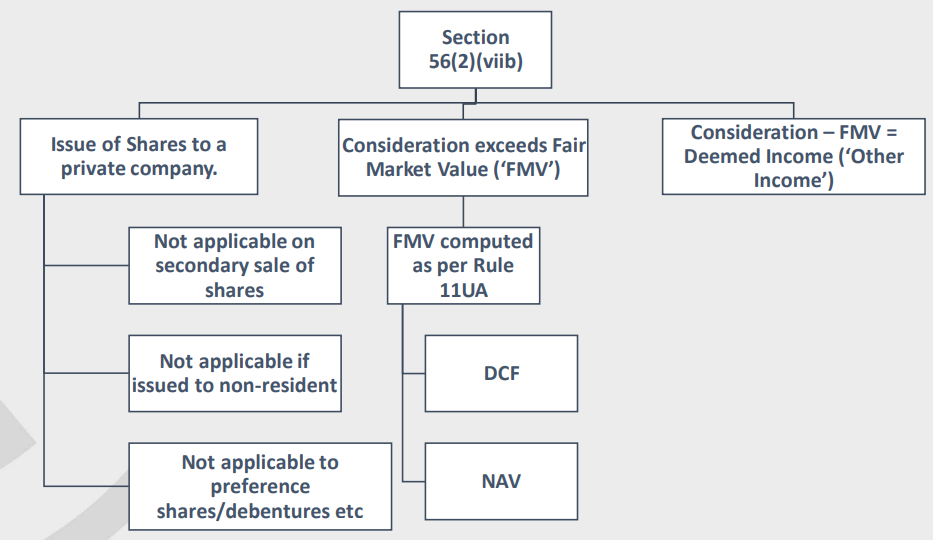Decoding the Recent Changes in Angel Tax Provisions
- Blog|Income Tax|
- 7 Min Read
- By Taxmann
- |
- Last Updated on 28 June, 2023
Table of Contents
- Background
- Angel Tax in News – Terror in Start-up Camp
- Section 56(2)(viib) – Snapshot (Old Law)
- How Section 56(2)(viib) Works? – Illustration
- Objective of Section 56(2)(viib)
- Pre vs Post Amendment – Snapshot
- Additional Methods
- Notified Entities
- Specified Nations
- Price Matching Method
- ‘Safe Harbour’ Concept
- Sec 56(2)(viib)- Whether Applicable to Preference Shares?
- Judicial Precedents
- Whether Applicable on Issue of CCDs?
- Judicial Precedents
- Concerns for Investors and Start-ups
- Planning Around Angel Tax
- Principles and Precedents
1. Background
- Startups mostly receive funding from HNIs, private companies, or consortium of private equity investors commonly known as Angels Investors
- The term “Angel” originated from the Broadway theater, where affluent individuals provided money for theatrical productions
- Prof. William Wetzel of University of New Hampshire coined the term “Angel Investor” in 1978 after completing a study on how entrepreneurs raised capital for businesses
- Since, the investment is received from Angel Investors, its taxation came to be known as ‘Angel Taxation’
2. Angel Tax in News – Terror in Start-up Camp
3. Section 56(2)(viib) – Snapshot (Old Law)
4. How Section 56(2)(viib) Works? – Illustration
- ‘X’ Co. issues equity shares to Mr. ‘A’ for a consideration of Rs. 1000/-
- FMV of the shares as computed under a valuation report is ascertained at Rs. 950/-
- Excess consideration received by ‘X’ Co. is Rs. 50/- (Rs. 1000 – Rs. 950)
- As per the provisions of Section 56(2)(viib) Rs. 50/- will be deemed to be income of X Co. from other sources and taxable at a rate of 30% (plus cess)
5. Objective of Section 56(2)(viib)
Memorandum to Finance Act 2023:
“Clause (viib) of sub section (2) of section 56 of the Act was inserted vide Finance Act, 2012 to prevent generation and circulation of unaccounted money through share premium received from resident investors in a closely held company in excess of its fair market value. However, the said section is not applicable for consideration (share application money/share premium) received from non-resident investors.
Accordingly, it is proposed to include the consideration received from a non- resident also under the ambit of clause (viib) by removing the phrase ‘being a resident’ from the said clause. This will make the provision applicable for receipt of consideration for issue of shares from any person irrespective of his residency status.”
6. Pre vs Post Amendment – Snapshot
| Pre-Amendment | Post-Amendment |
| Only ‘resident’ investors covered | Both ‘resident’ and ‘non resident’ investors covered |
| Rule 11UA – Only Two methods
(i) DCF (Discounted Cash Flow) (ii) NAV (Net Asset Value) method |
Five Additional Valuation methods provided under
Draft Rule 11UA for Non-residents (Aligning with FEMA) |
| Exclusions : DPIIT registered Start-ups (meeting specified conditions)
Amount of paid up capital does not include funds from Non-residents and Venture capital funds. |
Exemption from Angel Tax extended to ‘notified entities’ from ‘Specified Nations’ |
| Price Matching Method not available | Price matching Method for both resident and non-resident investors |
| Safe Harbor not available | Safe harbor for both resident and non-resident investors |
| Contemporaneous valuation report required but no time period for validity specified | 90 days specified as time period for validity of valuation report (at option of assessee) |
7. Additional Methods
- Existing Methods – DCF (Merchant Banker) and NAV – Available for Resident Investors
- Additional Methods (Merchant Banker) available only for Non Resident Investors
(i) Comparable Company Multiple Method
(ii) Probability Weighted Expected Return Method
(iii) Option Pricing Method
(iv) Milestone Analysis Method
(v) Replacement Cost Methods
- Objective to align with FEMA Rules which permit use of any internationally accepted valuation method
8. Notified Entities
Angel Tax Provision not to apply to following ‘Notified Entities’
- Government and Government related investors (central banks, sovereign wealth funds, international/multilateral organizations and entities controlled by Government etc);
- Banks or regulated entities involved in insurance business; and
- Following entities in ‘Specified Territories’ (21 countries)
-
- Entities registered with SEBI as Category-I FPI,
- Endowment funds (associated with university, hospitals or charities)
- Pension funds
- Broad-based pooled investment vehicle or fund with more than 50 investors (not being a hedge fund or fund which employs diverse or complex trading strategies)
9. Specified Nations
| 1. Australia | 8. France | 15. New Zealand |
| 2. Austria | 9. Germany | 16. Norway |
| 3. Belgium | 10. Iceland | 17. Russia |
| 4. Canada | 11. Israel | 18. Spain |
| 5. Czech Republic | 12. Italy | 19. Sweden |
| 6. Denmark | 13. Japan | 20. United Kingdom |
| 7. Finland | 14. Korea | 21. United States |
9.1 Mauritius, Singapore, Netherlands and UAE left out
| COUNTRY | Source of FDI into India (since FY 2000) |
| Mauritius | 1st |
| Singapore | 2nd |
| Netherlands | 4th |
| UAE | 7th |
- Raises questions regarding the narrow scope of the exempted 21 PE & VC funds from these countries contribute nearly 50% of foreign investment in India today.
- Interestingly, Mauritius has sought clarification regarding its exclusion from the list of exempted countries, even though the island nation complied with all 40 FATF recommendations on AML/CFT (anti-money laundering/countering financing of terrorism).
10. Price Matching Method
The price derived as ‘FMV’ by a ‘Notified’ entity can be taken (at option of the investee ) as ‘FMV for other investors (not ‘Notified’ entity) in another/subsequent round, if:
- Amount invested in next round does exceed the ‘aggregate consideration’ received from notified entity; and
- the prior investment round is within a period of 90 days from next issue of shares
10.1 Price Matching (Illustration)
- Notified entity subscribes to 1,000 equity shares of an unlisted company at FMV of INR 50 per share
- Investee has option to take INR 50 per share as FMV for other investors (not ‘Notified Entity’)
- However, this FMV can be applied upto investment of Rs 50,000 only (‘Aggregate Consideration’ Received’); and
- The subsequent investment has to be within 90 days of the receipt of consideration from ‘Notified Entity’
11. ‘Safe Harbour’ Concept
- Safe harbour of ‘not exceeding 10 percent’ made available – if issue price exceeds FMV by not more than 10 percent, issue price accepted as FMV
- Safe harbour available for both resident and non resident investors
- Available in case of DCF, NAV and additional methods
- Not available in case of ‘Price Matching’ Method
- Greater breathing room for start-ups
- Welcome move that recognizes valuation is not a science but a matter of perception
12. Sec 56(2)(viib)- Whether Applicable to Preference Shares?
Following incomes, shall be chargeable to income-tax under the head “Income from other sources”, namely:
where a company, not being a company in which the public are substantially interested, receives, in any previous year, from any person being a resident, any consideration for issue of shares that exceeds the face value of such shares, the aggregate consideration received for such shares as exceeds the fair market value of the shares:
- Express Language – ‘Issue of Shares’
- Term Used as ‘shares’ Not ‘preference shares’
- ‘Issue’ vs ‘Conversion’
- From hereon it’s a matter of interpretation
13. Judicial Precedents
In ACIT 16(1) v. Golden Line Studio (P.) Ltd. [2018] 98 taxmann.com 299/173 ITD 200 (Mum.-Trib) the Mumbai tribunal held that-
“The appellant had issued 6,10,825 Non-cumulative, non-convertible redeemable preference share at a premium of Rs. 490/- and the AO while applying S. 56(2)(viib) of Income Tax Act 1961 sought to bring the premium amount in the ambit of income. Court while rejecting the argument of the AO held that preference shares stand on a totally different footing as compared to equity shares and thus the S.56(2 (viib) cannot be made to apply circumstances”.
14. Whether Applicable on Issue of CCDs?
- S 56(2)(viib) states – “any consideration for issue of shares”
- Deeming provision only applicable to ‘issuance of shares’
- ‘conversion of CCDs to equity shares’
(i) No fresh infusion of capital
(ii) No consideration at the time of conversion
15. Judicial Precedents
In Bangalore v. M/s. CAE Flight Training (India) Pvt. Ltd., Bangalore tribunal held that –
“CCDs are to be considered as Debt only and the interest thereon has to be allowed and it cannot be disallowed by saying CCDs are equity and not debt”
In Secure Meter Ltd. (CC 10548/2009), Supreme Court held that –
“While confirming the order of Hon’ble High Court of Rajasthan confirmed the position that Compulsory Convertible Bonds represent the loan funds and this represent the The issue of bonds gives rise to a debt loan and not share capital and the expenditure incurred towards bonds should be considered as revenue in nature”
In DCIT v. Modern Syntex India Limited [2005] 3 SOT 27 /95 TTJ 161 (J.P.) held –
“That debenture is nothing but just another form of loan on which interest is payable. The debentures cannot be equated with As regards convertible debentures, the company may also issue other debentures in which case the option is given to the debenture holders to convert them into equity or preferential shares as stated rate of exchange after certain period. Thus, debenture conversion is also another form of loan for a specified period till they are converted into shares. Interest is payable on convertible debentures till they are converted into shares when dividend becomes payable”
16. Concerns for Investors and Start-ups
| Investor | Start-up |
| Must have tax efficient exit options | Downward pressure on valuation |
| Get an investment price that matches perception | Fear of Tax Scrutiny on valuation (plus tax litigation cost) |
| FEMA Regulations require investment above FMV but tax regulations tax excess | Unreasonable Tax Demands from start-ups already cash strapped |
| Investment must be at FMV (subject to 10% safe harbour) to satisfy both FEMA and Tax Regulations | Double Whammy for loss making Start-ups
– easy prey for Angel Tax Challenge |
17. Planning Around Angel Tax
- DPIIT Registration – Over 80,000 DPIIT-registered start-ups will not come within the tax purview, according to Indian Revenue Secretary (Sanjay Malhotra)
- Choice of Entity and Jurisdiction
(i) Flip Structure – take investment outside India
(ii) Notified entities in Specified Territories (full or part investment may be through Notified entity combined with Price Matching Method)
- Choice of Instrument
(i) CCPS – Technically not Shares but still risk of challenge
(ii) CCDs – Debt is much safer option
- Maintain Robust Valuation Report
- Backup projections based on underlying facts,
- Using growth rates/metrics that can be defended, and
- Realistic assumptions on revenue & costs
- Sanity check on Valuation Report Disclaimers
- Legal jurisprudence on valuation- Department cannot challenge expert’s valuation
18. Principles and Precedents
| Principles | Precedents |
| Valuation by an expert cannot be challenged | G.L. Sultania and Anr. (AIR 2007 SC 2172)
Dr. Renuka Datla [2004] 265 ITR 435 (SC) Miheer H. Mafatlal (AIR 1997 SC 506) |
| Valuation cannot be judged on hindsight | Cinestaan Entertainment Pvt Ltd
SEBI [2015(6) ABR 291] DQ(International) Ltd. (ITA 151/HYD/2015) |
| S 56(2)(viib) not applicable on Bonafide transactions | K.P. Varghese (131 ITR 597)
Subhodh Menon (ITA 676/Mum/2015) |
| Deeming Provisions afforded strict interpretation | Dilip Kumar & Co (2018) 9 SCC 1
Cinestaan Entertainment P. Ltd. ITA 1007/2019 |
| Business decisions of Assessee cannot be challenged | S.A. Builders (288 ITR 1)
Walchand and Co. P Ltd (AIR 1967 SC 1435) Dalmia Cement (B.) Ltd. (ITR 543 1983) |
Disclaimer: The content/information published on the website is only for general information of the user and shall not be construed as legal advice. While the Taxmann has exercised reasonable efforts to ensure the veracity of information/content published, Taxmann shall be under no liability in any manner whatsoever for incorrect information, if any.

Taxmann Publications has a dedicated in-house Research & Editorial Team. This team consists of a team of Chartered Accountants, Company Secretaries, and Lawyers. This team works under the guidance and supervision of editor-in-chief Mr Rakesh Bhargava.
The Research and Editorial Team is responsible for developing reliable and accurate content for the readers. The team follows the six-sigma approach to achieve the benchmark of zero error in its publications and research platforms. The team ensures that the following publication guidelines are thoroughly followed while developing the content:
- The statutory material is obtained only from the authorized and reliable sources
- All the latest developments in the judicial and legislative fields are covered
- Prepare the analytical write-ups on current, controversial, and important issues to help the readers to understand the concept and its implications
- Every content published by Taxmann is complete, accurate and lucid
- All evidence-based statements are supported with proper reference to Section, Circular No., Notification No. or citations
- The golden rules of grammar, style and consistency are thoroughly followed
- Font and size that’s easy to read and remain consistent across all imprint and digital publications are applied












 CA | CS | CMA
CA | CS | CMA


